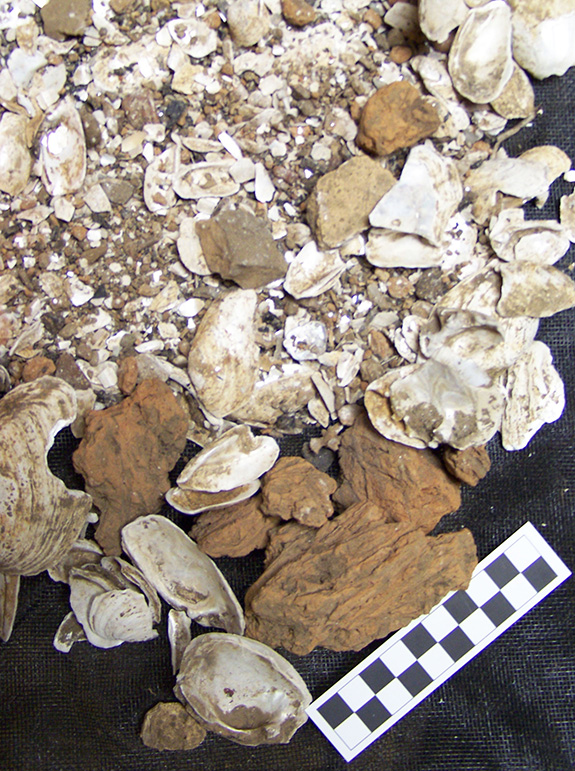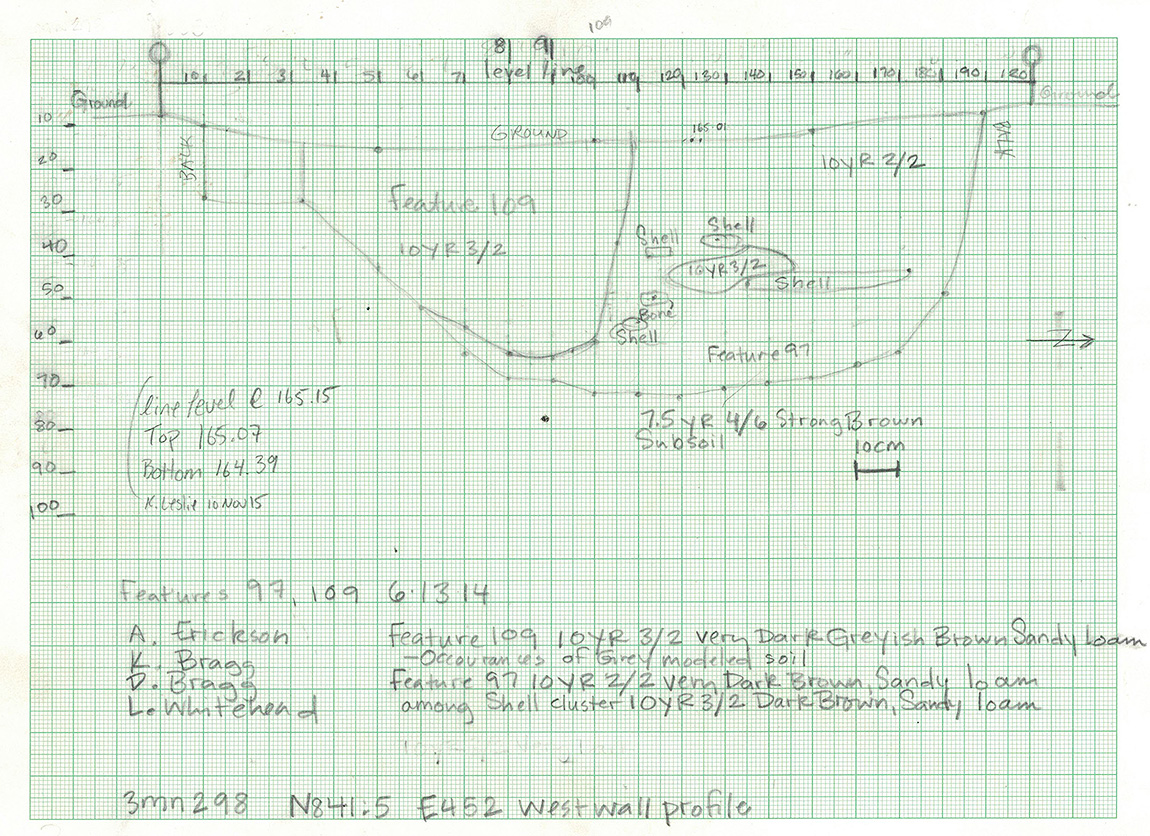
Mary Beth Trubitt (Arkansas Archeological Survey, HSU Research Station)
Feature of the Month - December 2023
As is often the case, participants in the Basic Excavation seminar at the 2014 Arkansas Archeological Society Training Program uncovered one of the most significant finds of the season. The site was Dragover, 3MN298, a large village in the upper Ouachita River valley with multiple periods of intensive use beginning about 2300 BC. During our research excavations, we recorded cultural features—including hearths, lines or arcs of postholes indicating house walls, and trash-filled pits—that give us important information on Caddo period lifeways in the Ouachita Mountains between AD 1200 and 1650 (Hanvey 2014; Trubitt 2019).

One large pit feature, Feature 97, provides data about ancestral Caddo foods and tools, and also confirms the location of previous archeological excavations. When initially uncovered in 2014, F-97 was a large dark semicircular patch of soil just below the ground surface. When fully exposed, F-97 was a large basin measuring 1.7 x 1.9 m across and 0.6 m deep. Whatever its original use, the pit was eventually used for waste disposal by residents in the past. Excavation revealed abundant organic material, especially animal bone, mussel shells, and charred wood, nutshell, and seeds. Since animal bone and shell is usually poorly preserved at sites in the Ouachita Mountains but was here in abundance, we took much of the pit fill as soil samples for water flotation processing. Our project archeobotanist, Leslie Bush, identified maize or corn cupules from the pit that were radiocarbon dated to 380 + 30 BP, producing a median probability of cal AD 1503 (Trubitt et al. 2016).
During excavation, it became clear that a second intrusive feature, designated F-109, cut into F-97. The modern age of this second feature became clear when pieces of Styrofoam cup were found in the fill! We now interpret F-109 as backfill from initial test excavations at the site in 1985; it corresponds to Feature 3 as described in that earlier report (Bennett et al. 1986).
Since the 2013–2014 excavations at 3MN298, the Arkansas Archeological Survey, Arkansas Archeological Society, and USDA Forest Service have funded radiocarbon dating and specialized archeobotanical and zooarcheological analyses. Artifacts have been analyzed and photographed, maps have been digitized, and I am writing a final report on the work. The artifact assemblage—especially the ceramic sherds—from F-97 will be a key context for defining a new archeological phase ca. AD 1500-1650 for the Ouachita Mountains region.


For further reading:
Bennett, William J., Jr., Anne Frances Gettys, and Aubra Lee (1986) Archeological Testing and Evaluation of 3MN298, Oden Ranger District. Archeological Assessments Report No. 26, submitted to the Ouachita National Forest, Hot Springs, Arkansas by Archeological Assessments, Inc., Nashville, Arkansas.
Hanvey, Vanessa N. (2014) Predictive Modeling of a Caddo Structure in the Ouachita Mountains, Montgomery County, Arkansas. Caddo Archeology Journal 24:43-52.
Trubitt, Mary Beth (2019) Ouachita Mountains Archeology: Researching the Past with Two Projects in Arkansas. Popular Series No. 6. Arkansas Archeological Survey, Fayetteville.
Trubitt, Mary Beth, and Katie Leslie (2015) Identity & Community in the Ouachita Mountains. Electronic resource, https://archeology.uark.edu/learn-discover/current-research/ouachita-mountains/.
Trubitt, Mary Beth, Leslie L. Bush, Lucretia S. Kelly, and Katie Leslie (2016) Ouachita Mountains Foodways: Preliminary Results from 2013-2014 Excavations at 3MN298. Caddo Archeology Journal 26:50-79.

Feature of the Month Series
Archeological features are elements or structures that are nonportable or cannot be easily removed from a site (such as a wall or a post hole). Archeologists document archeological features extensively in the field to record what will otherwise be destroyed in the process of excavation. The records of these features are often all that is left at the end of an excavation. Excellent record keeping is necessary for these features to provide insight into the archeological record and site formation.
In this series, we present interesting and important archeological features that have helped archeologists to better or more fully understand the sites on which they were working. New features will be added monthly. Find the list of features here.
